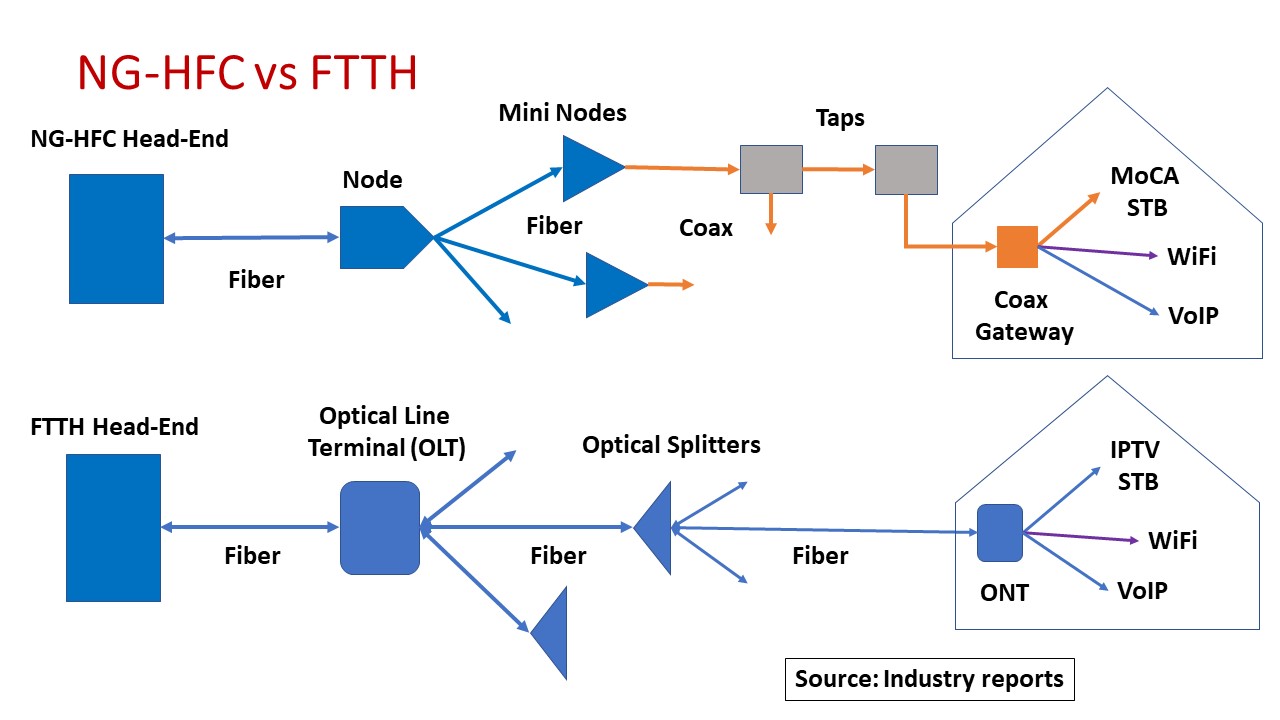Cable companies (cablecos) are at an interesting juncture in the evolution of their network infrastructure. Like their telephone company brethren, cablecos face continuing demand for high-speed broadband services.
To meet that demand, should they continue to enhance their legacy cable networks with next generation hybrid fiber-coax (NG-HFC) architecture or instead, adopt fiber-to-the-home (FTTH)?
In a recent Wells Fargo Securities webinar, cable experts, Broadband Success Partners (BSP), discussed the cablecos’ tradeoffs. Cablecos must weigh the factors of associated capital expenditures (capex), operating expenses (opex) and ultimately, customer satisfaction and retention. Those choices need to be made regardless of whether they are evolving to NG-HFC that leverages legacy coaxial cable burial or bypassing the coax altogether with FTTH.
NG-HFC involves a high-capacity fiber optic terminal at the head-end that connects to a fiber node which in turn feeds multiple mini nodes. These fiber-fed mini-nodes convert the digital signals to RF for transmission over a short coax drop from a tap to a residence. The incoming coax connects to a Coax Gateway that distributes throughout the house video to set-top boxes (STBs), high-speed internet access via a WiFi modem and voice over IP (VoIP).
As the name implies, FTTH involves a passive optical network (PON) that connects the head end directly to each home over fiber strands. The optical line terminal (OTL) acts like a network node but connects directly to an optical network terminal (ONT) at each home via passive optical splitters in the fiber line. Like the Coax Gateway, the ONT connects to terminal equipment that delivers revenue-producing video, data and VoIP services.
CableLabs, the cable industry’s non-profit research and development arm, created Data Over Cable Service Interface Specification (DOCSIS), an international telecommunications standard that adds high-bandwidth data transfer to an existing coaxial cable TV system.
DOCSIS has evolved to address the escalating “need for speed.” For instance, DOCSIS 3.0 specifies frequencies up to 750 MHz with data rates up 1 Gbps downstream and 100 Mbps upstream. DOCSIS 3.1 extended the upper end of the transmitted spectrum to over 1 GHz, providing more download bandwidth at the same upstream capacity.
DOCSIS 4.0’s key feature is Extended Spectrum DOCISIS (ESD) that expands downstream spectrum range to 1.8 GHz, and in future, up to 3 GHz, with flexible upstream split allocation at 300 MHz.
This enhanced performance comes at a price, however. Mini-nodes replace line amplifiers used to boost RF over coax. At the same, conventional taps need to be upgraded or removed altogether to handle the higher frequencies.
Since NG-HFC extends fiber closer to customers, then why not consider FTTH? FTTH removes the cost of line amplifier and tap upgrades and eliminates ongoing copper plant maintenance. Fiber cable, once installed, transmits greater bandwidths merely by changing the terminals at each end of the line.
Note that some large Tier 1 multiple system operators (MSOs) found the capex required for upgrades to NG-HFC was on par with new FTTH installations.
Opex differences are significant, however. Coax copper plant needs regular maintenance while a fiber plant requires no maintenance except for cable cuts.
Upgrading to NG-HFC can be a big disruptor, though. In-line mini-node installations and tap and coax splitter upgrades must be done on live service lines affecting dozens of homes at a time. By contrast, FTTH can be installed as an overlay to existing HFC plant. Individual homes then can be switched over to the new FTTH service sequentially, thereby minimizing disruption.
In either scenario, scheduled in-home customer visits are necessary to upgrade the terminal equipment that delivers similar video, data and voice services at comparable equipment costs. With significant long-term operating advantages over NG-HFC and new revenue-generating service potential, FTTH is fast becoming the network infrastructure of choice among cablecos.
by John Celentano, Inside Towers Business Editor





Reader Interactions